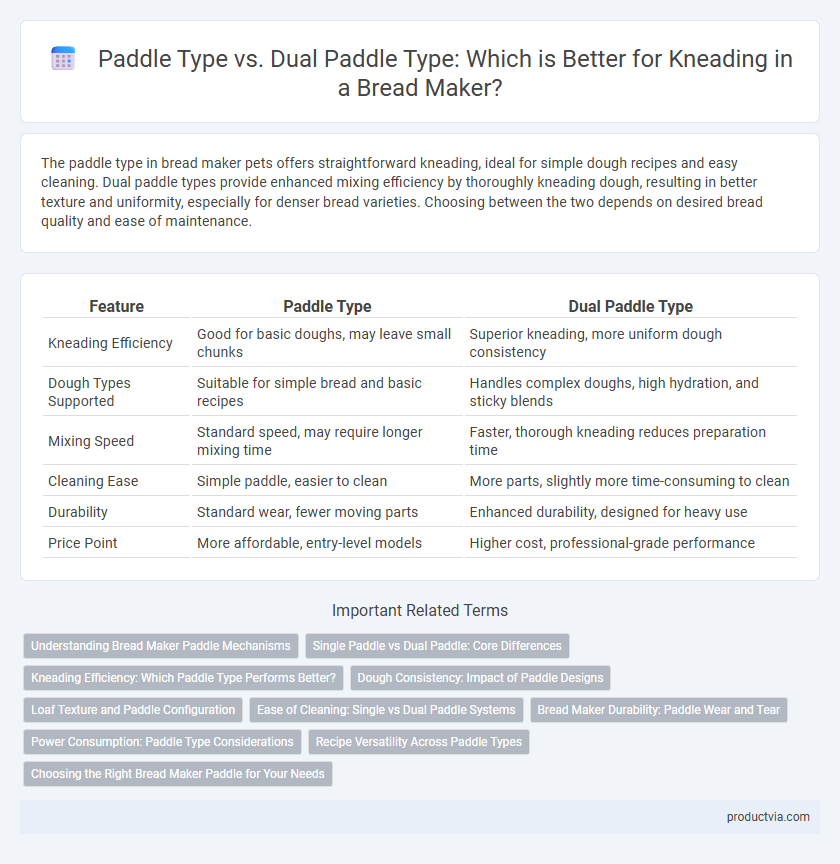The paddle type in bread maker pets offers straightforward kneading, ideal for simple dough recipes and easy cleaning. Dual paddle types provide enhanced mixing efficiency by thoroughly kneading dough, resulting in better texture and uniformity, especially for denser bread varieties. Choosing between the two depends on desired bread quality and ease of maintenance.
Table of Comparison
| Feature | Paddle Type | Dual Paddle Type |
|---|---|---|
| Kneading Efficiency | Good for basic doughs, may leave small chunks | Superior kneading, more uniform dough consistency |
| Dough Types Supported | Suitable for simple bread and basic recipes | Handles complex doughs, high hydration, and sticky blends |
| Mixing Speed | Standard speed, may require longer mixing time | Faster, thorough kneading reduces preparation time |
| Cleaning Ease | Simple paddle, easier to clean | More parts, slightly more time-consuming to clean |
| Durability | Standard wear, fewer moving parts | Enhanced durability, designed for heavy use |
| Price Point | More affordable, entry-level models | Higher cost, professional-grade performance |
Understanding Bread Maker Paddle Mechanisms
Bread makers with a single paddle use one mixing blade to knead the dough, which often leaves a small tunnel inside the loaf due to uneven kneading. Dual paddle types feature two blades that rotate simultaneously, promoting more thorough and consistent kneading to produce a uniform crumb structure. Understanding the mechanical difference in paddle design helps in selecting a bread maker that ensures improved dough development and better bread texture.
Single Paddle vs Dual Paddle: Core Differences
Single paddle bread makers offer simpler kneading by using one kneading blade, which can be sufficient for basic dough recipes but may struggle with dense or large batches. Dual paddle bread makers feature two blades that provide more efficient and even kneading, resulting in better gluten development and a more consistent dough texture. The core difference lies in kneading power and thoroughness, where dual paddles enhance dough quality by mimicking hand-kneading more closely than single paddles.
Kneading Efficiency: Which Paddle Type Performs Better?
Dual paddle types generally provide superior kneading efficiency compared to single paddle types by ensuring more thorough dough mixing and consistent texture. The dual paddles work simultaneously to stretch and fold the dough, reducing mixing time and improving gluten development. This results in better dough elasticity and higher-quality bread with fewer unprocessed lumps.
Dough Consistency: Impact of Paddle Designs
Paddle type bread makers generally use a single kneading paddle that provides consistent dough movement but may leave more large air pockets. Dual paddle type machines feature two kneading paddles that work simultaneously to produce more uniform dough consistency and better gluten development. The dual paddle design more effectively mixes ingredients and reduces uneven dough textures, resulting in improved bread crumb structure.
Loaf Texture and Paddle Configuration
Dual paddle type bread makers provide more consistent kneading compared to single paddle models, resulting in a uniformly dense and well-textured loaf. Single paddle machines may leave a hole at the bottom due to uneven kneading, whereas dual paddles ensure thorough dough mixing and better gluten development. The dual paddle configuration enhances the bread's crumb structure and rise, producing a softer, more evenly baked loaf.
Ease of Cleaning: Single vs Dual Paddle Systems
Single paddle bread makers offer greater ease of cleaning due to fewer parts and simpler design, reducing the risk of dough residue buildup in hard-to-reach areas. Dual paddle systems, while improving kneading efficiency, often require more thorough cleaning efforts to remove dough from both paddles and the central shaft. Choosing a paddle type impacts maintenance time, with single paddles providing quicker, more straightforward cleanup.
Bread Maker Durability: Paddle Wear and Tear
Dual paddle types in bread makers enhance kneading efficiency but often experience increased wear and tear compared to single paddle designs. Bread maker durability depends heavily on the material quality and engineering of the paddles, with stainless steel options showing superior resistance to abrasion and deformation. Choosing a bread maker with replaceable or reinforced dual paddles can extend appliance lifespan and maintain optimal dough consistency over time.
Power Consumption: Paddle Type Considerations
Single paddle bread makers consume less power due to a simpler motor mechanism focused on one kneading blade, optimizing energy efficiency during dough mixing. Dual paddle machines, while offering superior kneading performance with two blades, typically require higher power consumption to drive both paddles simultaneously. Energy considerations favor single paddle models for lower electricity use, though dual paddle units enhance dough consistency at the cost of increased power demand.
Recipe Versatility Across Paddle Types
Dual paddle bread makers offer enhanced recipe versatility by thoroughly kneading denser doughs like whole grain or gluten-free varieties, ensuring consistent texture and rise. Single paddle machines work well for standard white or basic bread recipes but may struggle with heavier ingredients or complex dough formulations. Choosing dual paddles supports diverse baking needs, accommodating a wider range of recipes and ingredient mixes.
Choosing the Right Bread Maker Paddle for Your Needs
Choosing the right bread maker paddle depends on the type of kneading and dough consistency you need; single paddles offer efficient kneading for basic recipes and easy removal, while dual paddles ensure more thorough mixing and uniform dough development for complex or heavier doughs. Dual paddle types reduce the risk of unkneaded flour pockets and improve the bread's texture, making them ideal for artisan and whole grain breads. Consider your baking frequency and recipe variety to determine whether the simplicity of a single paddle or the enhanced performance of dual paddles best suits your bread-making needs.
Paddle type vs Dual paddle type for kneading Infographic

 productvia.com
productvia.com